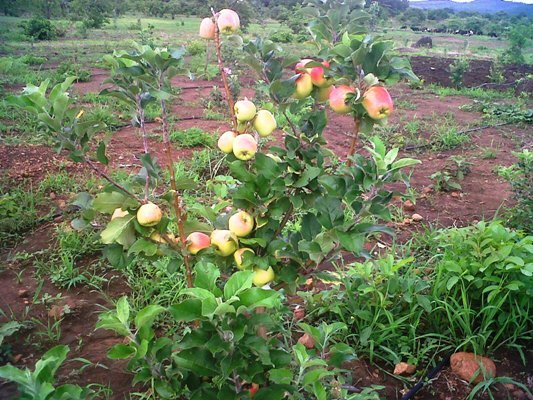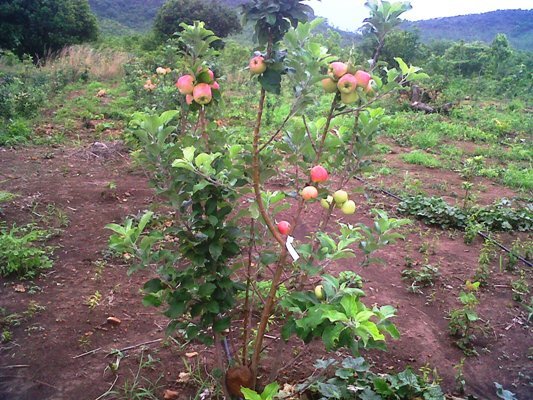APPLE CULTIVATION TECHNIQUES

There's an adage that says 'an apple a day keeps the doctor away'. this is due to the numerous health benefits of the apple. but very few people know how this apple is grown. Here, i'm going to show a detailed method of apple cultivation.
HOW TO PLANT
Spring planting is suggested in central , northern regions. Where fall and winter climate is for the most part mellow and wet, fall planting is effective.
ATMOSPHERIC CONDITIONS
Only one out of every odd apple develops all over the place. Every type has a particular number of days required for organic product development.
Tree tags don't generally reveal to you where the assortment develops best, yet numerous indexes do. Additionally check with your nearby Cooperative Extension Service for a proposal particular to your region.
Every specie has various chill hours expected to set organic product (i.e., the measure of time temperatures are in the vicinity of 32 and 45 degrees F). The more distant north you go, the more chill hours an apple assortment needs to evade pre-summer solidify issues.

LAND AND SOIL
Take a dirt test preceding planting your apple trees. Your nearby Cooperative Extension Service can teach you in gathering the dirt example, enable you to translate the outcomes, and give important data about the dirt in your region. Results from the dirt test will decide the dirt changes important to amend supplement insufficiencies and modify soil pH. The corrections ought to be worked into the dirt to a profundity of 12 to 18 inches where the tree will root, not only the planting opening.
Apple trees require all around depleted soil, nothing excessively wet. Soil should be modestly rich and hold dampness and also air; mulch with straw, feed, or some other natural material to keep soil sodden and give supplements as they break down.
Pick a sunny site. For best fruiting, an apple tree needs "full daylight," which implies at least six long stretches of direct summer sun day by day. The best introduction for apples is a north-or east-bound slant.
Tree separating is affected by the rootstock, soil fruitfulness, and pruning. Seedlings or full-estimate trees ought to be planted around 15 to 18 feet separated in succession. An overshadowing rootstock may be 4 to 8 feet separated in succession.
Smaller person apple trees are famously inclined to evacuating under the heaviness of an overwhelming harvest, so you ought to give an emotionally supportive network to your fence. You can develop your trees against a fence, or you can give unattached help as a trellis.
Ensure the tree won't be planted in an "ice take" where chilly air settles in low-lying territories. Pick a higher site with a slip if conceivable so icy air will stream far from the trees.
Try not to plant trees close lush territories or trees.
PUTTING THE TREE IN THE GROUND
Before planting, evacuate all weeds and the grass in a 4-foot distance across circle.
After you buy the tree, shield it from damage, drying out, solidifying, or overheating. In the event that the roots have dried out, absorb them water around 24 hours before planting.Burrow an opening around double the measurement of the root framework and 2 feet profound. Place a portion of the free soil once again into the gap and slacken the dirt on the dividers of the planting gap so the roots can undoubtedly enter the dirt. Spread the tree roots free to move around at will soil, ensuring they are not wound or swarmed in the opening. Keep on replacing soil around the roots. As you cover the roots, firm the dirt to make sure it encompasses the roots and to evacuate air pockets.
Try not to include manure at planting time, as the roots can be "singed". Fill the rest of the gap with the free soil, and press the dirt down well.
Most apple trees are united. The unite association must be no less than 2 creeps over the dirt line with the goal that roots don't rise up out of the scion. The join association (where the scion is connected to the rootstock) can be perceived by the swelling at the intersection.
.jpeg)
CARE OF APPLE TREES
Limit Pruning of a Young Tree
Pruning moderates a youthful tree's general development and can defer fruiting, so don't be in a rush to prune, other than expelling lost, broken, or dead branches. There are a few procedures to coordinate development without overwhelming pruning. For instance:
Rub off lost buds previously they develop into lost branches.
Twist a stem down on a level plane for fourteen days to moderate development and advance branches and fruiting. Secure with strings to stakes in the ground or to bring down branches.
Prune a Mature Tree Annually
Once an apple tree has filled in and is proving to be fruitful, it requires normal, direct pruning.
Prune your develop tree when it is lethargic. Totally remove excessively lively, upright stems.
Expel feeble twigs (which frequently dangle from the undersides of appendages.
Abbreviate stems that turn out to be excessively sagging, particularly those low in the tree.
After around ten years, fruiting goads (squat branches that lengthen just about a half-inch every year) move toward becoming packed and incapacitated. Remove some of them and abbreviate others.
At the point when an entire appendage of fruiting goads decreases with age, slice it back to account for a more youthful substitution.
TRIM THOROUGHLY
Thin or evacuate overabundance natural product. This appears to be hard however this training levels out generation, keeps a substantial yield from breaking appendages, and guarantees better-tasting, bigger organic product edit.
Not long after organic product set, evacuate the littlest natural products or harmed ones, leaving around four creeps between those that remain.
.jpeg)
PESTS/DISEASES
Apples are inclined to bugs. Here are a few pointers:
Keep deer under control with anti-agents, fencing, or deer-safe plants; hinder mice and rabbits with wire-work barrels around the base of the tree.
Splashes might be required for creepy crawlies like Japanese scarabs, albeit one of the most noticeably awful guilty parties, the apple slimy parasite, can be caught essentially enough by hanging maybe a couple round, softball-measure balls—painted red and covered with sticky "Tangle-Trap"— from a branch in June through the mid year. Reapply the sticky goo a period or two, as essential.
Battle off sicknesses by raking apple leaves, covering them underneath mulch, or pounding them with a lawnmower at season's end.
Pruning diminishes ailment by letting in more light and air.
To fend off bugs from apple trees, influence an answer of 1 some vinegar, some sugar, and 1 quart of water. Empty this blend into a widemouthed plastic container.
HARVESTING AND STORAGE OF APPLES
Reap patiently. After such an excess of pruning and minding, make sure to gather your apples at their pinnacle of flawlessness. Cull your apples when their experience shading is never again green.
Diverse apple assortments develop at various circumstances, so the gather season can extend from August to October.
Now, the stem should part promptly from the branch when the organic product is measured in the palm of your hand and given a slight wind around, at that point up. if the apple is overripe and delicate, use for cooking!
STORAGE
Just store mid or late season apples. Early season assortments don't keep and are best eaten not long after in the wake of picking. Mid season assortments should keep for half a month, while late season assortments will remain in great condition for anyplace up to a half year. Apples bound for capacity must be impeccable, without any wounds or flaws that could give passage focuses to decay.
Store apples by wrapping up singular natural products in daily paper or tissue paper. Place the wrapped apples onto plate that enable air to circle. You can likewise store them unwrapped, yet the organic products ought not contact. Diverse assortments store for various periods of time, so keep them particular and eat those that won't store as long first.
The perfect store is some place dim, very much ventilated, and cool however ice free. Most carports and sheds are perfect, while lofts and cellars ought to be maintained a strategic distance from because of either intemperate warmth, absence of ventilation or low moistness. Check put away apples routinely and expel any that are going delicate, darker or decaying.
One small farm at a time, thanks for enlighten us on apples and its benefits
Resteem
(to be a part of this community; ensure to always use #farms and #steemchurch for agricultural related post)
SteemChurch Farm ( @FARMS)